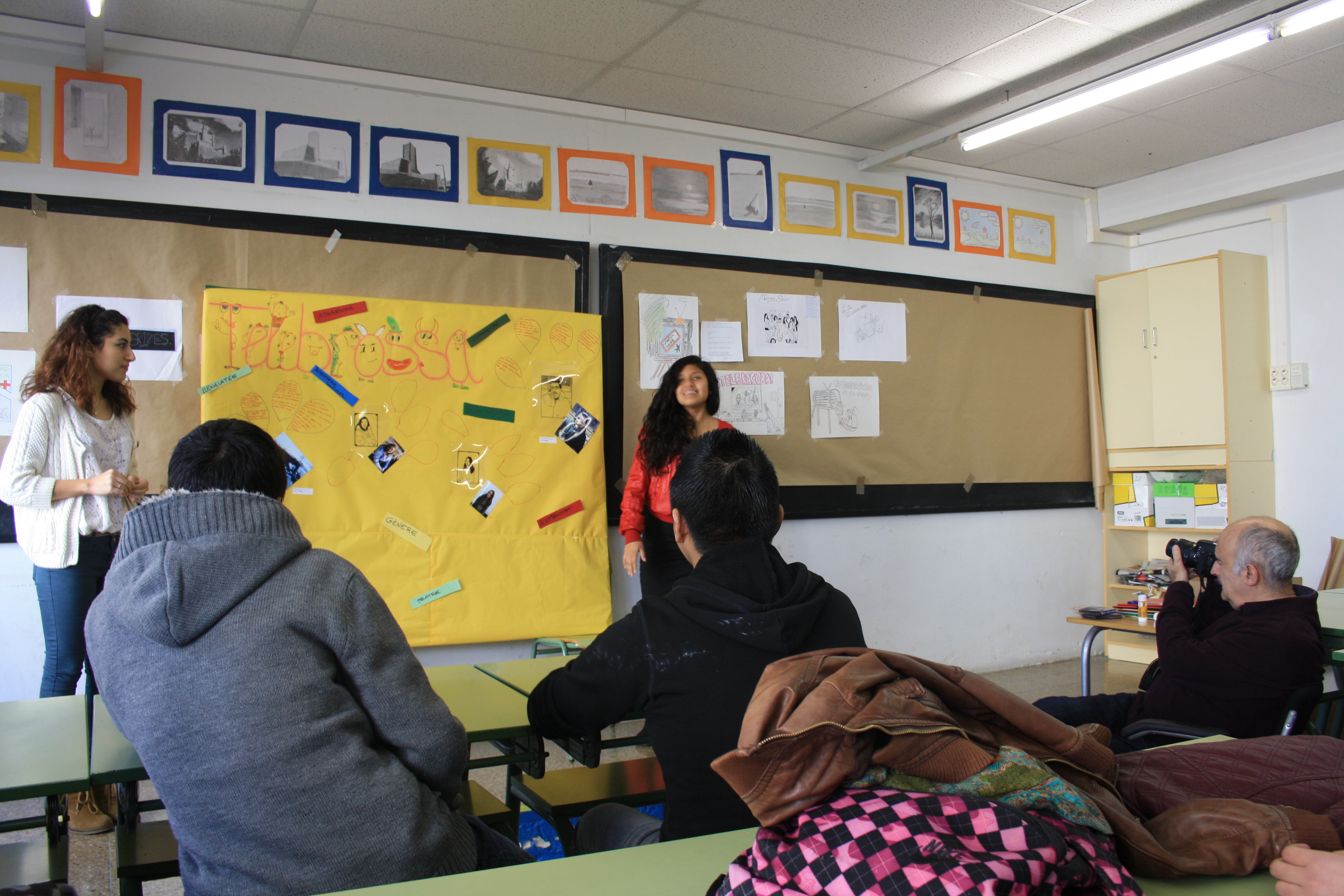Institut Torres i Bages (Secondary School) - Spain
Region: L’Hospitalet del Llobregat, Catalonia
Other schools in the Quad Blog: Muurolan Peruskoulu (Finland), Jesus and Mary Secondary School Gortnor Abbey (Ireland), Chenderit School (UK)
Creative Connections Project: Crisis/politics and popular culture

Fig 1; Torres i Bages students meetings Photo by Ana Cañete
Context
Secondary school located in L'Hospitalet de Llobregat, a neighbouring city of Barcelona that has 257,057 inhabitants. The city is the second largest in Catalonia with 20,691 inhabitants per square kilometre. It is the most densely populated city in Spain and one of the largest in Europe. The Institut Torres i Bages Secondary School has four classes of Secondary Education (O-levels), two of Bachillerato (A-levels), two of the Newcomers programme and two of Aula Abierta (Non-Curriculum Specific). The school currently has 584 students.
Participants
The Creative Connections project was undertaken by two classes of the 4th year of secondary education (20 students per class, 40 in total) and the teacher with a MA student from programme: Art and Education: A constructionist approach from the University of Barcelona.
Process
The Creative Connections project was developed in the Visual and Plastic Education class which was taught for two hours a week for each group. From the beginning of the project in September 2012 the teacher attended all the group monthly meetings of researchers and teachers. The purpose of the monthly meetings was to plan how to develop the project in each school in accordance to their needs and context. In Torres i Bages the Creative Connections project was implemented from December 2012 to June 2013.
At the beginning of the project the teacher and students were already working on topics related to cultural activism. This has been of special interest to the students as they wanted to discuss the economic crisis. Their interest in cultural activism developed further after a visit to an exhibition on El Roto (a Spanish illustrator whose drawings contain a strong social criticism), which took place in the city of l'Hospitalet de Llobregat, in the cultural centre Tecla Sala.
From this visit and through working on the project, the students were grouped according to their affinities and topics of interest, which were: the crisis, politics, popular culture, television, sports and the environment.
Initially the students started to think about doing some individual sketches for a future collective work. But instead they separated into small groups according to their own interests, to begin a long and thorough process of inquiry that concluded with an art work by each group. This work related to and inspired both the proposed topics above and from the Art Database of the project.
For some students, the use of topics was only the beginning of a much more complex associative process and had more implications than they thought, and as the project developed many groups rebuilt and suggested new topics of work. The groups worked very independently, with the support of the teacher and the MA student during school hours.
When the topics of work were clear, it was time to see how they could materialise their sketched ideas from the inspired by the Art Database. This part of the project was the most complicated. It was hard for the students to turn their conceptual thinking into a concrete project. To do this they organised a series of classroom meetings to work collectively on their issues. The teacher and MA student started by look for a much deeper conceptual approach to the work that was created. Together they created a list of concepts/words that related to each of the topics that they had been working on. The students took turns to choose concepts that had been previously written on strips of cardboard. In turn, each group discussed their work with the others, so that their choices were problematized and new ideas were contributed. In this way, the students began to become aware of the relevance of the ideas that they had themselves, and it was also an opportunity to see the work of other classmates.
Once they reflected on the conceptual implications, they proceeded to choose an artist or more than one, from which they could establish a dialogue based on their own work. Images from the artists of the Creative Connections Database acted as a space where they could dialogue and express themselves.
This dialogue supported them in extracting ideas for their own work which led to each group not only picking a particular artist from which to work with, but also realising that their works had different implications on different levels with other artists. For example, some artists helped them to reflect on their topics of interest, others on the format or technique and other artists were interested in a purely aesthetic matter and particular taste. This also led them to investigate more about the artist, out of the information offered by the Creative Connections website.
Once the plan of work was designed, the concepts chosen, and ideas drawn from each artist, they then went onto work on the production of their work. The hours of work in the classroom alternated with brainstorming sessions to share with their peers in the other class on what they were doing. The presentation days and discussion groups were organised and were filmed.
Achievement
Definitely the Institut Torres i Bages was one of the most active in the project. This was largely due to the enthusiasm of the teacher, working with students and sharing all the process in the meetings with teachers and researchers. Because of the way the groups worked, the students’ art works were complex and had a deep social meaning that materialised in the large pieces which allowed the groups to articulate collectively their social interests.
Finally they were very active in using the Creative Connections website; not only by sharing their final works but throughout the entire creative process.


